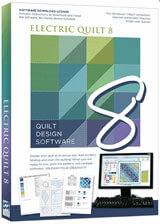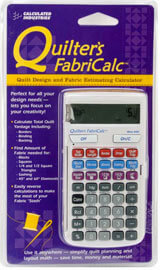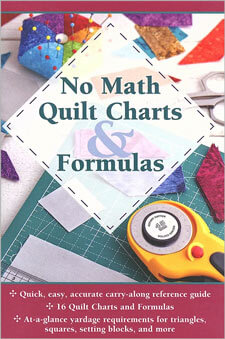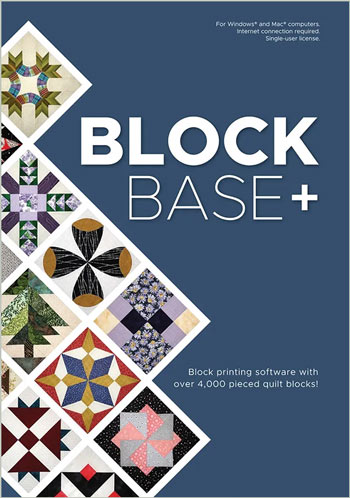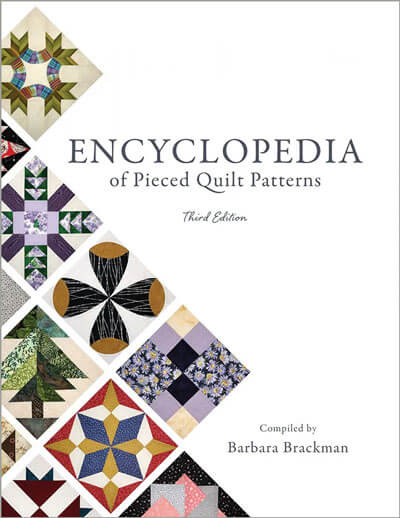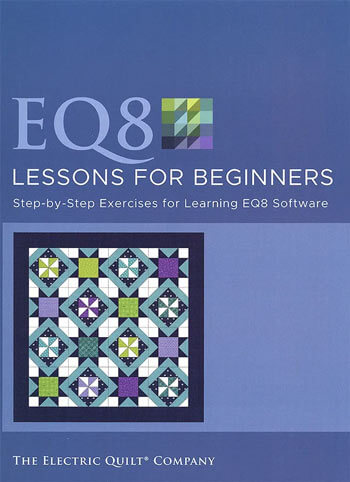- Home
- Quilt Design Inspiration
- Quilt Fabric Yardage
Calculating Quilt Fabric Yardage 101
Using a Rail Fence quilt as an example
This post contains affiliate links, for which I receive compensation.
A quilter, Lorraine G., recently asked for quilt fabric yardage requirements for a quilt she planned to make.
Specifically she wanted to know:
"How much fabric do I need for a Rail Fence in 3 colors and with 10" and 12" finished blocks?
Also what are the cut width sizes for these.
I need a quilt that is about 90" square."
With only three unique patches (and all of the same size) to consider, this question provides the perfect example for learning to calculate yardage requirements.
There are two ways to do it.
In the first section we'll explore using quilt design software (EQ7) to figure it out.
Further down this page, we'll use paper, pencil and a calculator starting with a list of the orderly steps in the calculations and then going through our Rail Fence example with two different block design.
Let's get started!
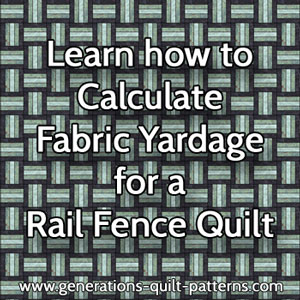 Remember to Pin for later!
Remember to Pin for later!Using design software for fabric yardage calculations
Due to its limited fabric palette, strip piecing is the most efficient way to piece this quilt.
Using this technique means each strip's width must be easy to cut with a rotary cutter and ruler—that means no 1/3" units since the majority of rotary rulers are labelled in 1/4" and 1/8" increments.
The only ruler I've ever seen with 1/3" increments is the Wonder Ruler, click here to learn about it.
To meet Lorraine's requirements and this cutting limitation, I drafted two different blocks into my Electric Quilt—a quilt design software for both the PC and Mac.
Option 1
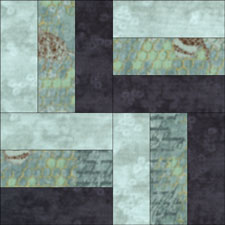 A Rail Fence block made from four 3-strip units
A Rail Fence block made from four 3-strip unitsIn this first option (left), each 6-1/2"(unfinished) unit contains a unique patch from each of the three fabrics.
Four units are then stitched into a block that measures 12-1/2" unfinished (12" finished).
Using a straight set layout of 8 x 8 blocks, the finished patchwork measures 96-1/2" square including 1/4" binding, slightly above Lorraine's size requirement.
The patchwork design looks like this...
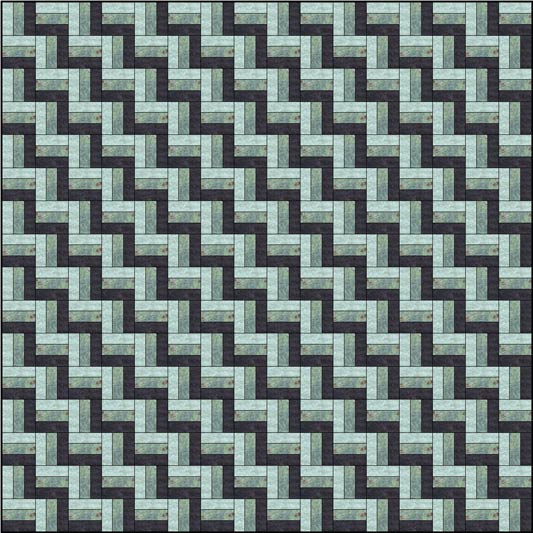 Rail Fence quilt design, 8x8 blocks
Rail Fence quilt design, 8x8 blocksFor the patchwork design above, the program returned these yardages:
- Dark: 3-5/8 yds
- Medium: 3-5/8 yds
- Light: 3-5/8 yds
You will need additional fabric for binding. At this time (Nov. '20) these calculations are not available within the EQ program.
On this site, there are charts to help you determine the amount of binding you'll need based on the size of your quilt. Click here for that information.
Where to find the calculations in EQ:
In the EQ program, from the 'Quilt Worktable', click the 'Print & Export' option at the top (5th option over from the left) and then select 'Yardage' from the Print Menu that appears.
You have the option to choose the fabric width (remember this is the 'usable' width) from 5 preset values and then change the size of your seam allowance.
Once you've made these selections, then either print or preview the yardage requirements.
Option 2
In this second block option, the strips from these three fabrics are cut 1-1/2" wide.
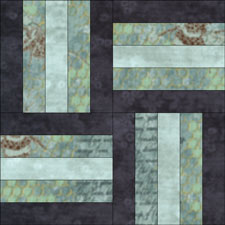 A Rail Fence block made from 4 5-strip units
A Rail Fence block made from 4 5-strip unitsThe 5-1/2" unfinished units contain 5 strips. Unlike Option 1 where each fabric is used just once, here the dark and medium fabrics are each used twice in each unit.
Four units are joined into a block measuring 10-1/2" unfinished (10" finished).
81 blocks are laid out in nine rows of 9 each. The finished patchwork measures 90-1/2" square including 1/4" binding.
The fabrics required as calculated in the EQ program are:
- Dark: 4-5/8 yds
- Medium: 4-5/8 yds
- Light: 2-5/8 yds
As before, you'll need additional fabric for binding.
The design looks like this...
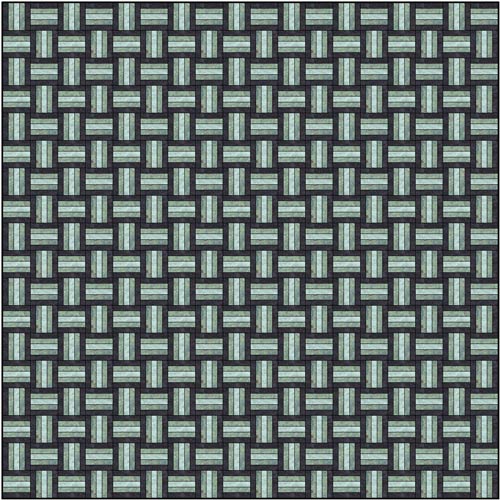 Rail Fence quilt design, 9x9 blocks
Rail Fence quilt design, 9x9 blocksSwap the position and yardage for just the light and dark fabrics and the patchwork design morphs into this...
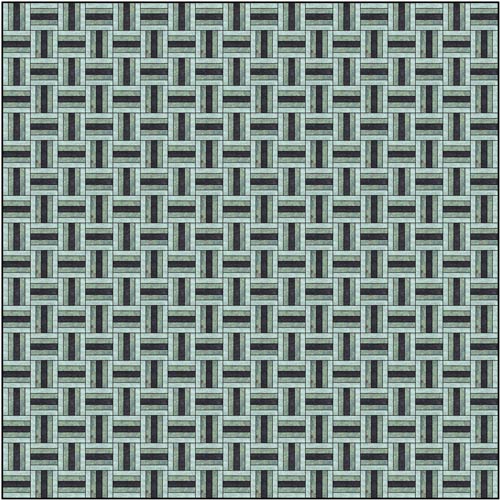
The choice is yours!
In drafting this design, it becomes quite apparent that there MUST be a distinct difference in the values of the light, medium and dark fabrics.
Otherwise the design gets really smushy and almost disappears. (Click here to see what I mean!)
What if you don't have the EQ software?
Never fear!
There's ALWAYS more than one way to get things done in quilting.
The trick is finding what works best for YOU and what best fits your budget.
To compute the needed quilt fabric yardage, you'll need paper, pencil and a calculator (if you don't care to do the math in your head).
You'll need to have a quilt design with all of its unique patches identified and sized.
Let's get started!
Simple steps for manually figuring quilt fabric yardage
To determine how much fabric is needed to make a quilt, we compute the amounts needed for each unique patch in the design using the following steps:
- Choose the method of piecing: Different techniques have different fabric requirements (for examples visit Beginner Quilt Block Patterns and Units)
- Identify the usable width of fabric (this can change from fabric to fabric and may be quite different for unwashed versus prewashed fabrics). Please read this caution about different fabric widths. Usable width equals the full width from selvedge to selvedge MINUS the selvedges.
- Identify each unique patch in the design.
- Determine how many of a unique patch can be cut from the usable width of fabric.
- How many strips will it take to get the required quantity of a unique patch.
- Multiply the number of strips by the strip's width.
- Add your personal 'insurance'.
- Record and label the result in an orderly fashion so it's easy to recall at a later date.
Tools to make quilt designing easier...
Click any image for more information, reviews, and pricing.
The Calculations
For both options, the blocks are strip pieced from fabric strips with a usable width of 40"
Block 1 Option

To review:
- Blocks are 12" finished
- 2-1/2" strips of each fabric are needed
- Units are 6-1/2" square unfinished
- Make 64 blocks (8x8 layout)
- There are three unique patches—a light rectangle, a medium and a dark one—in each unit
How many of the unique light patch are needed?
Simply count how many times the light patch appears in the block. In the diagram above it's 4 times.
Multiply this by the number of blocks that contain it:
4/block x 64 = 256 light patches
How many light patches can be cut from a width of fabric?
Each light patch is 2-1/2" x 6-1/2" where 6-1/2" is the unfinished length of a unit. The computation is:
40" strip ÷ 6.5" = 6.153
The decimals go on and on, but there's no need to go further than 3 places.
Since we can't piece with partial patches, round down to get 6 unique light patches from one strip
How many strips are needed?
Simply do the math.
256 patches ÷ 6 patches/strip = 42.666 strips
This time round up because we use full strips, so it takes a total of 43 strips to cut 256 light rectangles.
How much fabric is needed without insurance?
Remember our strips are cut 2-1/2" wide. Determine the number of inches needed by multiplying:
43 strips x 2.5" = 107.5 inches
To convert to yardage divide by 36":
107.5" ÷ 36" = 2.986 yards
Round up to a number your local quilt store will be happy to cut or 3 yards.
Determine your 'insurance'
Insurance will differ from quilter-to-quilter and patch-to-patch.
EQ calculated 3-5/8 yards of a light is needed. The program added an additional 5/8 yds or 22-1/2" extra.
Only you can decide if that is right for you. Some of the things that whittle away at the extra inches include:
- Fabric shrinkage if you prewash (it tends to shrink more on the crosswise grain and you may not get as many patches from each strip after washing)
- Squaring up after several of cuts
- Fewer patches can be cut from strips cut crooked at the fold
- Miscuts
- Using a fabric cutting machine like an Accuquilt
For this quilt, 5/8 yard looks like a fair amount. Any leftovers can be used in a scrap quilt later, or perhaps even in a pieced backing for THIS quilt.
Since each unique patch is identical in size, the quilt fabric yardage for the medium and dark fabrics is also equal to 3 yards PLUS your insurance amount.
Block 2 Option

To calculate the quilt fabric yardage for our Option 2 block, follow the same steps, noting that:
- Blocks are 10" finished
- 1-1/2" wide cut strips are needed
- The units are 5-1/2" square unfinished
- Make 81 blocks
Plugging in these values for the dark or medium fabrics:
8/block x 81 blocks = 648 patches
40"/strip ÷ 5.5"/unit = 7.272 or 7/strip
648 patches ÷ 7/strip = 92.571 or 93 strips
93 x 1.5"(strip-width) = 139.5"
139.5" ÷ 36" = 3.875 or
3-7/8 yards each of a dark and a medium PLUS your insurance
Repeat the process for the light (remember it's only used once in each unit):
4/block x 81 blocks = 324 patches
40"/strip ÷ 5.5"/unit = 7.272 or 7/strip
324 patches ÷ 7/strip = 46.285 or 47 strips
47 x 1.5" = 70.5"
70.5" ÷ 36" = 1.958 rounded up to 2 yards PLUS your insurance
A note about 'usable width' and strip piecing...
The strip piecing technique adds an extra 'twist' on the quilt fabric yardage calculations.
If all the rectangles are cut and stitched individually, then it doesn't make any difference if the yardage is of different widths—simply do the computations for each unique patch from each unique fabric.
With strip piecing, the fabric-strips are sewn together, pressed and then cut into units/patches. If there are several different usable widths, then use the narrowest measurement for the calculations for each fabric used in the strip set.
You can easily see how a narrower width could possibly effect the number of patches able to be cut from each set.
A review of the steps to calculating quilt fabric yardage...
Now this was a simple exercise without a lot of patches to consider.
Regardless of how simple or complicated your quilt design is, the steps are exactly the same.
- Identify the technique
- Identify the unique patches
- Identify the usable width of all your fabric choices
- How many can you cut from a strip
- How many strips do you need
- Multiply strips by cut width
- Divide by 36" to calculate exact yardage
- Add insurance 'cause stuff happens in quilting
Calculating quilt fabric yardage is no more difficult than that. Just more or less depending on the design.
My best advice
Write everything down. Date it, too.
That way you have a record if you have to come back at a later time.
It's faster to check your work, than recalculate everything.
Take it one step at a time.
You've got this!
